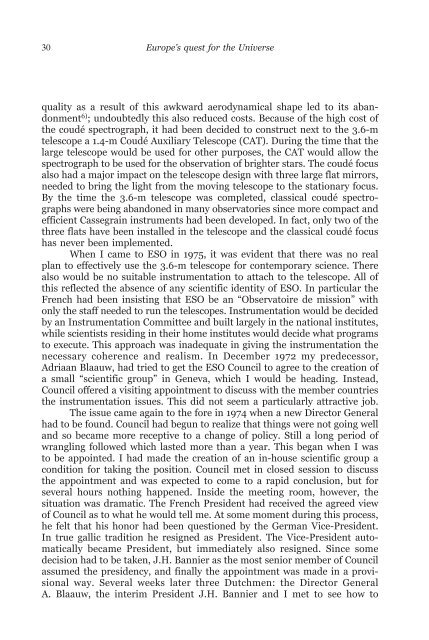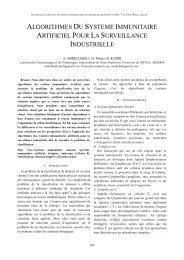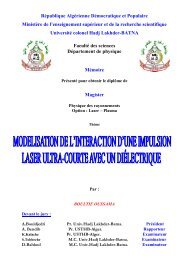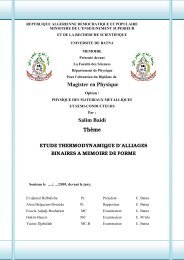Europe's Quest for the Universe - Laboratoires de Recherche
Europe's Quest for the Universe - Laboratoires de Recherche
Europe's Quest for the Universe - Laboratoires de Recherche
Create successful ePaper yourself
Turn your PDF publications into a flip-book with our unique Google optimized e-Paper software.
30 Europe’s quest <strong>for</strong> <strong>the</strong> <strong>Universe</strong><br />
quality as a result of this awkward aerodynamical shape led to its abandonment<br />
6) ; undoubtedly this also reduced costs. Because of <strong>the</strong> high cost of<br />
<strong>the</strong> coudé spectrograph, it had been <strong>de</strong>ci<strong>de</strong>d to construct next to <strong>the</strong> 3.6-m<br />
telescope a 1.4-m Coudé Auxiliary Telescope (CAT). During <strong>the</strong> time that <strong>the</strong><br />
large telescope would be used <strong>for</strong> o<strong>the</strong>r purposes, <strong>the</strong> CAT would allow <strong>the</strong><br />
spectrograph to be used <strong>for</strong> <strong>the</strong> observation of brighter stars. The coudé focus<br />
also had a major impact on <strong>the</strong> telescope <strong>de</strong>sign with three large flat mirrors,<br />
nee<strong>de</strong>d to bring <strong>the</strong> light from <strong>the</strong> moving telescope to <strong>the</strong> stationary focus.<br />
By <strong>the</strong> time <strong>the</strong> 3.6-m telescope was completed, classical coudé spectrographs<br />
were being abandoned in many observatories since more compact and<br />
efficient Cassegrain instruments had been <strong>de</strong>veloped. In fact, only two of <strong>the</strong><br />
three flats have been installed in <strong>the</strong> telescope and <strong>the</strong> classical coudé focus<br />
has never been implemented.<br />
When I came to ESO in 1975, it was evi<strong>de</strong>nt that <strong>the</strong>re was no real<br />
plan to effectively use <strong>the</strong> 3.6-m telescope <strong>for</strong> contemporary science. There<br />
also would be no suitable instrumentation to attach to <strong>the</strong> telescope. All of<br />
this reflected <strong>the</strong> absence of any scientific i<strong>de</strong>ntity of ESO. In particular <strong>the</strong><br />
French had been insisting that ESO be an “Observatoire <strong>de</strong> mission” with<br />
only <strong>the</strong> staff nee<strong>de</strong>d to run <strong>the</strong> telescopes. Instrumentation would be <strong>de</strong>ci<strong>de</strong>d<br />
by an Instrumentation Committee and built largely in <strong>the</strong> national institutes,<br />
while scientists residing in <strong>the</strong>ir home institutes would <strong>de</strong>ci<strong>de</strong> what programs<br />
to execute. This approach was ina<strong>de</strong>quate in giving <strong>the</strong> instrumentation <strong>the</strong><br />
necessary coherence and realism. In December 1972 my pre<strong>de</strong>cessor,<br />
Adriaan Blaauw, had tried to get <strong>the</strong> ESO Council to agree to <strong>the</strong> creation of<br />
a small “scientific group” in Geneva, which I would be heading. Instead,<br />
Council offered a visiting appointment to discuss with <strong>the</strong> member countries<br />
<strong>the</strong> instrumentation issues. This did not seem a particularly attractive job.<br />
The issue came again to <strong>the</strong> <strong>for</strong>e in 1974 when a new Director General<br />
had to be found. Council had begun to realize that things were not going well<br />
and so became more receptive to a change of policy. Still a long period of<br />
wrangling followed which lasted more than a year. This began when I was<br />
to be appointed. I had ma<strong>de</strong> <strong>the</strong> creation of an in-house scientific group a<br />
condition <strong>for</strong> taking <strong>the</strong> position. Council met in closed session to discuss<br />
<strong>the</strong> appointment and was expected to come to a rapid conclusion, but <strong>for</strong><br />
several hours nothing happened. Insi<strong>de</strong> <strong>the</strong> meeting room, however, <strong>the</strong><br />
situation was dramatic. The French Presi<strong>de</strong>nt had received <strong>the</strong> agreed view<br />
of Council as to what he would tell me. At some moment during this process,<br />
he felt that his honor had been questioned by <strong>the</strong> German Vice-Presi<strong>de</strong>nt.<br />
In true gallic tradition he resigned as Presi<strong>de</strong>nt. The Vice-Presi<strong>de</strong>nt automatically<br />
became Presi<strong>de</strong>nt, but immediately also resigned. Since some<br />
<strong>de</strong>cision had to be taken, J.H. Bannier as <strong>the</strong> most senior member of Council<br />
assumed <strong>the</strong> presi<strong>de</strong>ncy, and finally <strong>the</strong> appointment was ma<strong>de</strong> in a provisional<br />
way. Several weeks later three Dutchmen: <strong>the</strong> Director General<br />
A. Blaauw, <strong>the</strong> interim Presi<strong>de</strong>nt J.H. Bannier and I met to see how to






